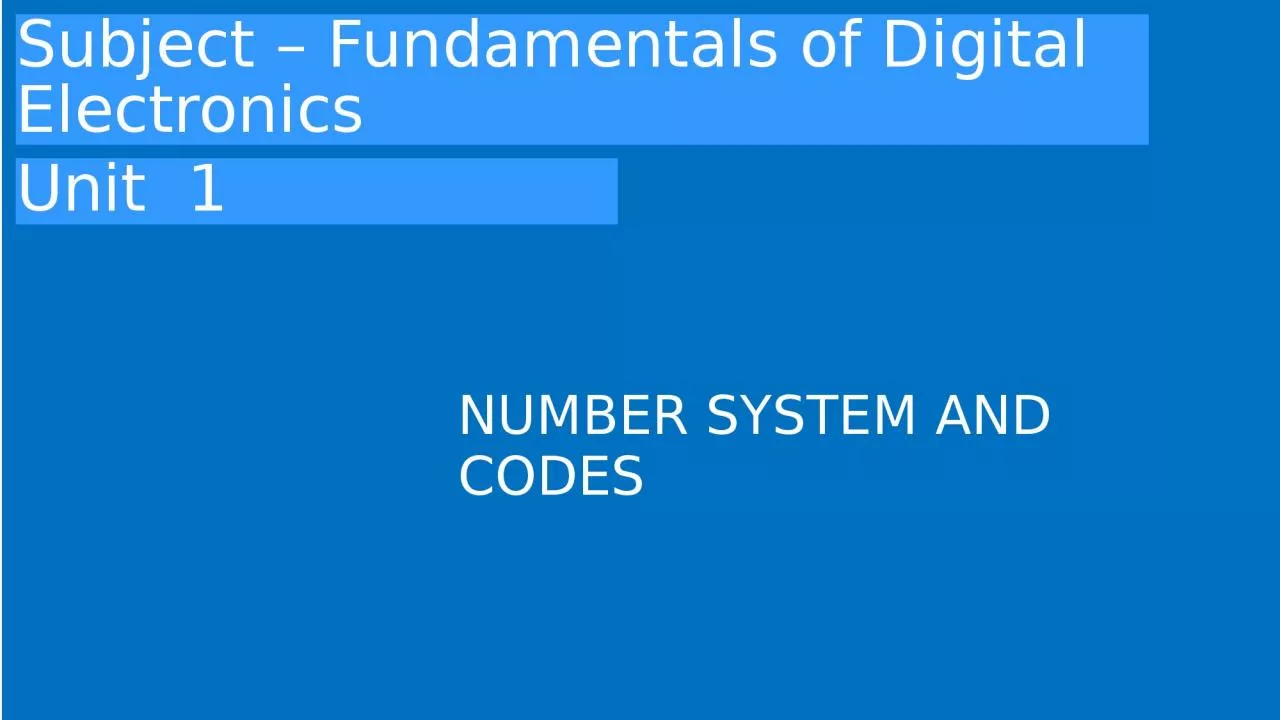/
 " class="ldpb">
" class="ldpb">
 " class="plbg" style="object-fit: cover;" >
" class="plbg" style="object-fit: cover;" >
arapptxBodypsppsppnvSpPrpcNvPr id5 nameTitle 1pcNvSpPr txBox1aspLockspcNvSpPrpnvPrpnvSpPrpspPr bwModeautoaxfrmaoff x150680 y139211aext cx10790894 cy1236371axfrmaprstGeom prstrectaavLstaprstGeomasol ID: 1047445
" rel="nofollow" class="dwnldLnk" id="dlink" >Download Presentation The PPT/PDF document "Unit 1
1. Unit 1
2. Contents1.1 Number system types1.2 Conversion from one number system to another number system 1.3 Binary arithmetic 1.4 Complementation method1.5 Codes1.6 Error detecting and correcting code
3. What is Number system? It is a system in which various symbols are used to represent and track the count of the things.E.g. to count days between consecutive rainfalls. There are two types of number system1. Non-positional number system 2. Positional number system
4. Non-positional number systemIn this system same type of symbols are used to represent any number, and the position of symbol does not have any value. E.g.: 1 - I 2 - II 3- III III
5. Positional number systemIn this system different symbols are used to represent a number and place of the symbol has value. E.g.: 2 , 145, 1E25 and 52Binary number system Decimal number system Octal number system Hexadecimal number system
6. Binary number systemThe number system with base two is known as binary number system. In this number system only two symbols are used to represent any number .and these symbols(0,1) are known as bits. E.g. (110)2 1x22+ 1x21 +0x201x4+1x2+04+2+06
7. Decimal number system The number system with base ten is known as decimal number system. In this number system ten symbols are used to represent any number .and these symbols(0,1,2,3,4,5,6,7,8,9) are known as digits.E.g. (2461)102 x 103 + 4 x 102 + 6 x 101 + 1 x 1002x1000 + 4x100 + 6x10 +1x12000+400+60+12461
8. Octal number systemThe number system with base eight is known as octal number system. In this number system eight symbols are used to represent any number .and these symbols are (0,1,2,3,4,5,6,7)E.g. :- (436)8
9. Hexadecimal number system The number system with base sixten is known as hexadecimal number system. In this number system 16 symbols are used to represent any number .and these symbols are digit from 0 to 9 and letters from A to F, these letters are used to represent numbers from 10 to 15Digits- 0 to 9 (0,1,2,3,4,5,6,7,8,9) = 10 DigitsLetters- A to F A-10, B-11, C-12, D-13, E-14 and F - 15 = 6 LettersTotal symbols = Digits + letter = 10 + 6 = 16
10. Conversion from Decimal to Binary with StepsWrite the given decimal numberIf the given decimal number is less than 2 the binary number is the same.If the decimal number is greater than 1 then divide the number by 2 .Note the remainder we get after divisionRepeat step 3 and 4 with the quotient till it is less than 2Now, write the remainders in reverse order(bottom to top)The resultant is the equivalent binary number to the given decimal number.
11. Conversion from Decimal to Binary
12. Conversion from Decimal to Octal with StepsWrite the given decimal numberIf the given decimal number is less than 8 the octal number is the same.If the decimal number is greater than 7 then divide the number by 8.Note the remainder we get after divisionRepeat step 3 and 4 with the quotient till it is less than 8Now, write the remainders in reverse order(bottom to top)The resultant is the equivalent octal number to the given decimal number.
13. Conversion from Decimal to Octal
14. Conversion from Decimal to Hexadecimal with StepsWrite the given decimal numberIf the given decimal number is less than 16 the hexadecimal number is the same.If the decimal number is greater than 15 then divide the number by 16Note the remainder we get after divisionRepeat step 3 and 4 with the quotient till it is less than 16Now write the remainders in reverse order(bottom to top)The resultant is the equivalent hexadecimal number to the given decimal number.
15. Conversion from Decimal to Hexadecimal
16. Binary addition rules
17. Examples
18. Binary subtraction Examples
19. Binary division rules:1 ÷ 1 = 1 1 ÷ 0 = 0 0 ÷ 1 = undefined 0 ÷ 0 = undefined
20. Example :
21. Binary multiplication rules:0 × 0 = 01 × 0 = 00 × 1 = 01 × 1 = 1
22. Example :1 0 1 0 0 1 × 1 1 0________________ 0 0 0 0 0 0 1 0 1 0 0 1+ 1 0 1 0 0 1_________________ 1 1 1 1 0 1 1 0
23. 1’s Complement i) Take 1’s complement of the negative number. ii) Then add this with positive number.
24. Example :